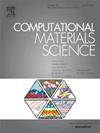通过数据驱动的随机森林和有限元模拟挖掘双相钛合金的微观结构特征与动态压缩性能之间的关系
IF 3.1
3区 材料科学
Q2 MATERIALS SCIENCE, MULTIDISCIPLINARY
引用次数: 0
摘要
为了优化钛合金的动态压缩性能,有必要揭示微观结构特征与动态机械性能之间的内在关系。在这项工作中,提出了一种基于真实微观结构和参数建模的动态压缩数值模拟方法,并进行了实验验证。随后,通过高通量模拟计算了 4075 组双相 TC6 钛合金的动态压缩模拟结果。随后,利用数据驱动的随机森林算法建立了旨在预测钛合金动态强度(σ)和动态塑性(ε)的回归模型和四分类模型。回归模型的拟合优度为 0.99,而四分类模型的 F1 分数为 0.88。此外,结合夏普利加法解释(SHAP),发现次生α相的宽度(Sw)和原生α相的体积分数(Pf)是最关键的微观结构特征。同时,通过对典型微结构模型的局部应力和绝热剪切敏感性分析,揭示了上述规律背后的内在机制。最后,通过对无动态塑性断裂数据集的进一步分析,确定了动态力学性能优异的微观结构特征范围(Sw 为 1 μm,Pf 为 0.1 至 0.2。这些发现可为后续优化钛合金动态机械性能的实验工作提供重要参考。本文章由计算机程序翻译,如有差异,请以英文原文为准。
Mining the relationship between microstructural characteristics and dynamic compression properties of dual-phase titanium alloys via data-driven random forest and finite element simulation
To optimize the dynamic compression properties of titanium alloys, it is necessary to reveal the internal relationship between microstructural characteristics and dynamic mechanical properties. In this work, a dynamic compression numerical simulation approach, based on realistic microstructures and parametric modeling was proposed and validated experimentally. Following this, 4075 sets of dynamic compression simulation results for dual-phase TC6 titanium alloys were calculated by high-throughput simulation. Subsequently, a regression model and a four-classification model, aiming to predict the dynamic strength (σ) and dynamic plasticity (ε) of titanium alloys, were established by the data-driven random forest algorithm. The regression model attained a goodness-of-fit metric of 0.99, while the four-classification model achieved an F1-score of 0.88. Further, combined with the Shapley additive explanations (SHAP), it was found that the width of secondary α phase (Sw) and the volume fraction of primary α phase (Pf) were the most critical microstructural characteristics. Specifically, Pf was negatively correlated with σ and ε, whereas Sw was negatively correlated with σ but positively correlated with ε. Meanwhile, intrinsic mechanisms behind the above laws were revealed through local stress and adiabatic shear sensitivity analyses of typical microstructure models. Finally, the range of microstructural characteristics of excellent dynamic mechanical properties (a Sw of 1 μm and a Pf ranging from 0.1 to 0.2.) was determined by further analysis of datasets without dynamic plastic fracture. These findings can provide a significant reference for subsequent experimental efforts to optimize the dynamic mechanical properties of titanium alloys.
求助全文
通过发布文献求助,成功后即可免费获取论文全文。
去求助
来源期刊

Computational Materials Science
工程技术-材料科学:综合
CiteScore
6.50
自引率
6.10%
发文量
665
审稿时长
26 days
期刊介绍:
The goal of Computational Materials Science is to report on results that provide new or unique insights into, or significantly expand our understanding of, the properties of materials or phenomena associated with their design, synthesis, processing, characterization, and utilization. To be relevant to the journal, the results should be applied or applicable to specific material systems that are discussed within the submission.
 求助内容:
求助内容: 应助结果提醒方式:
应助结果提醒方式:


